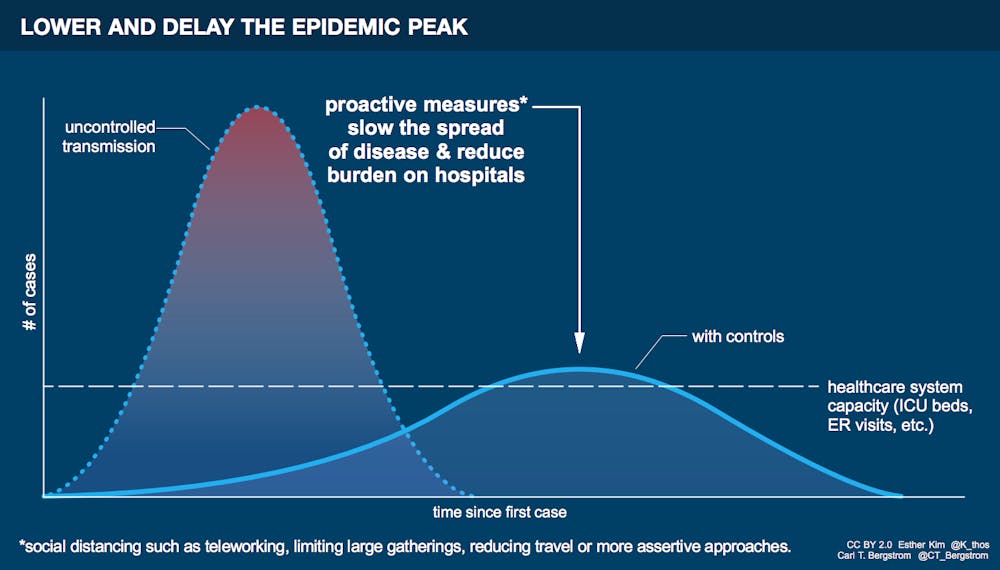As the number of coronavirus cases continue to rise across the world, public health officials are recommending social distancing as a measure to slow the spread of the virus. Because we are innately social beings, this public health practice has been challenging and has required substantial lifestyle adjustments.
However, social distancing is scientifically justified. Social distancing measures are enacted to reduce the spread of a contagious disease, in this case COVID-19, by preventing opportunities for a sick person to come in contact with healthy individuals. Some current social distancing measures include public and private universities closing and transitioning to remote learning, companies asking employees to telecommute and businesses modifying their daily hours.
From shelter-in-place orders in California and Illinois, to restaurants and bars closing at 5 p.m. in Minnesota, states are promoting social distancing in various ways. Across the nation, practicing social distancing includes avoiding large group gatherings and activities, and maintaining at least six feet of distance from others whenever possible.
Why is practicing social distancing effective? The 1918 U.S. flu epidemic established precedent, with studies finding that the cities that practiced social distancing slowed the spread of the flu the fastest and emerged from the epidemic with lower mortality rates.
Public health experts and mathematical epidemiologists urge people to socially distance in order to reduce transmission of the virus.
Hopkins experts Dr. Joshua Sharfstein, Jennifer Baker and Katherine Connolly authored a joint statement for The News-Letter on the science behind social distancing.
Sharfstein is the vice dean for Public Health Practice and Community Engagement at the Bloomberg School of Public Health and directs the Bloomberg American Health Initiative. Baker is an MPH candidate at the Bloomberg School of Public Health and Connolly is an MPH/MBA candidate at the Bloomberg School of Public Health and Carey School of Business.
Sharfstein, Baker and Connolly explained the essential purpose behind enacting social distancing measures.
“The goal of social distancing is to slow the spread of the virus in order to reduce the burden on health-care systems and workers,” they wrote.
Both asymptomatic individuals and those displaying symptoms can transmit the virus. Therefore, it is important that everyone social distances.
Taylor McIlquham, an infection control epidemiologist at Hopkins Medicine, explained that the COVID-19 virus spreads in a manner similar to other respiratory viruses.
“When someone coughs or sneezes, respiratory droplets containing the virus are able to travel up to six feet,” she said in an interview with The News-Letter.
Imagine a scenario in which one asymptomatic person at work coughs continuously while having a conversation with a coworker. The coworker, who was standing less than six feet away, has come in contact with the virus and returns home, where he eventually infects his family. McIlquham warns that this can have serious repercussions for high risk populations.
“The virus will continue to spread person-to-person and eventually infect elderly or immunocompromised people who are at high risk of severe illness,” she said.
Transmission of the virus follows the domino effect. Social distancing measures, such as staying six feet apart, are preventative; they reduce the probability of the first domino falling.
The coronavirus is rapidly spreading, with the number of cases from the end of January to today following an exponential curve. At the rate the virus is being transmitted, the number of daily cases will surpass the health-care system’s capacity. Social distancing must be practiced in order to “flatten the curve,” or reduce the number of daily cases overtime.
Sharfstein, Baker and Connolly noted that the flattest curve is formed through extensive social distancing when compared to a forced quarantine or moderate social distancing.
“At this moment, extensive social distancing is recommended to put the brakes on infection, for several reasons including giving the health-care system more time to prepare,” they wrote.
While social distancing will slow the spread of the virus, other simultaneous measures are necessary to stop it. Regular hand-washing, staying as isolated as possible and quarantine of affected individuals will aid in ending the pandemic.
Social distancing limits our physical connections with friends and families but does not affect our ability to communicate virtually. Sharfstein, Baker and Connolly described how around the world, communities are finding creative ways to come together while practicing social distancing through events like virtual happy hours, shared streaming sessions or balcony concerts. Other ways of coping with the lack of social interaction include focusing on personal physical and mental health by going for a walk or recording something to be grateful for each day.
McIlquham noted that the Centers for Disease Control and Prevention (CDC) has recommended practicing social distancing for at least the next six weeks. Sharfstein, Baker and Connolly, however, believe that social distancing will be required for months.
“The length of time [of social distancing] really depends on whether or not people follow those guidelines,” McIlquham added.
As testing continues, the disease affects a larger portion of the population every day. For now, individuals are urged to continue practicing social distancing and to plan on continuing it.
“Any Johns Hopkins University student could be a bridge to infection by someone in a high-risk population,” Sharfstein, Baker and Connolly wrote. “It is essential that all young people do their part to protect the community and flatten the curve.”

















